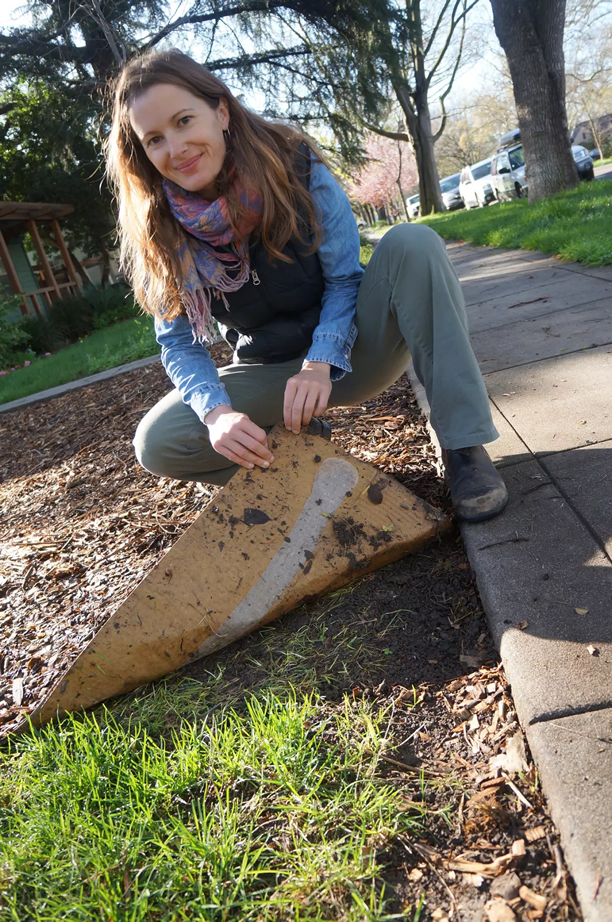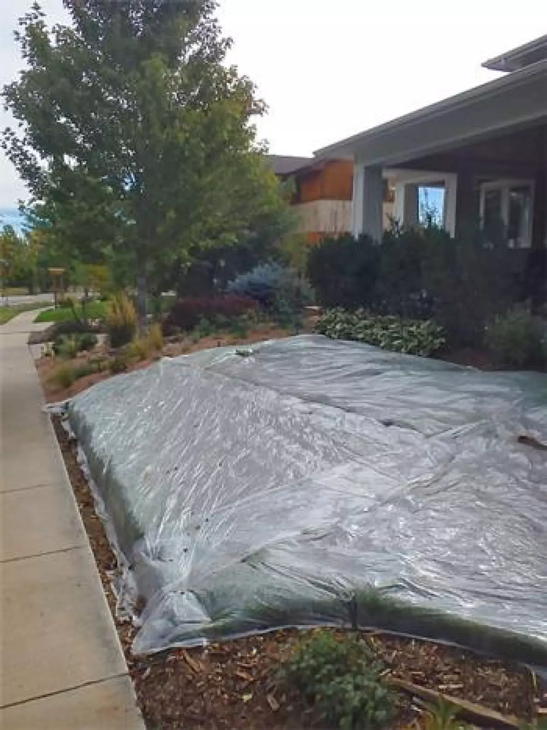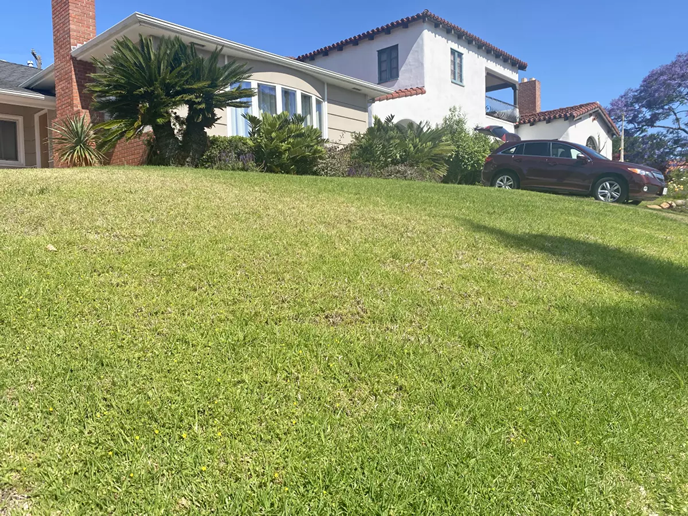Time to cut grass? 4 ways to ditch your lawn in this desert we call San Diego

Stacey Parker, a horticulturist for the UC Davis Arboretum and Public Garden, shows the effect cardboard has on lawn removal. (UC Agriculture and Natural Resources)
Getting rid of sod takes effort, patience, but the low-water rewards are worth it
San Diego is paradise. Warm days, no snow, minimal frost, and an average of 146 sunny days surrounded by 117 partly sunny days. That leaves only 84 days without some sun. Not counting this weird spring, we live in a predictably wonderful climate. What could be better? Well, maybe a little more rain.
Our yearly average rainfall is less than 12 inches. This fits the definition of a coastal desert: cool winters followed by moderately long, warm summers with a range of 2 inches to 14 inches of rain per year. While homeowners might lust for a tropical garden, it takes about 1.5 inches of water per week to provide the beautiful, lush green lawn that some would like to see.
Maybe it is time to consider alternative landscaping.
The first step when converting a conventional-style landscape is to remove the lawn. There are several methods to choose from, and while none are fast or easy, it will be worth the effort when your new drought-tolerant garden is installed. Here are four popular methods to kill your lawn:
Sheet mulching
Stacey Parker, teaching assistant at UC Davis and the director of Public Horticulture and Engagement at the UC Davis Arboretum and Public Garden, wrote extensively as she transformed her lawn into a low-water landscape with a method that she calls “sheet mulching.” She recommends waiting until early spring to allow for months of heat to destroy the small-rooted grasses like fescue. Here are her four steps:
1. Cut the lawn as low as possible.
2. Cover it with cardboard or paper.
3. Dampen the cardboard.
4. Add 4 to 5 inches of mulch to smother the lawn.
Covering your lawn with paper or cardboard, overlapping the edges by several inches to prevent weeds from crawling through and preventing sunlight from allowing photosynthesis, and a large dose of patience will result in a dead lawn. This should take several months to complete, which will give you time to plan your new garden and to begin planting in the fall, usually the best time to plant.
Parker outlines her process in detail at bit.ly/CardboardRemoveLawn.
Solarization

Solarization is an effective lawn removal technique. The plastic sheeting traps heat and moisture and eventually kills the lawn. (UC Agriculture and Natural Resources)
Solarization has been found to be very effective in killing the fat-rooted grasses like Bermuda. It uses layers of plastic, trapping heat and moisture. Without oxygen, carbon dioxide and water, the grass eventually dies. This process takes about six weeks but can vary depending on the amount of sunlight and heat. The area should have a minimum of six hours of full sun per day.
Steps to successful solarization:
1. Mow and dig out the edges of your lawn.
2. Water deeply.
3. Use thick clear plastic sheeting, 2 millimeters thick.
4. Lay plastic over the lawn, overlapping any seams by 6 inches.
5. Trench the edges and secure with bricks, sand or soil to prevent water and air from entering.
6. Observe for tears or deterioration of the plastic, and repair with duct tape to prevent air and water from entering the area.
The Southern California Water Authority has detailed instructions on this process at bit.ly/BeWaterwiseSolarize and bit.ly/SolarizationPestControl.

Keeping a lawn lush requires 1 to 1.5 inches of water per week. Replacing a lawn with drought-tolerant landscape saves hundreds of gallons of water per year. (Jodi Bay)
Physical removal
One of the fastest ways to rid your garden of lawn is to physically remove it. If you have a large lawn,you can use a “sod cutter” device that can be rented through equipment rental companies and big box stores.
You can also use a garden spade, which will take more time and energy, so the option may work best with small and irregularly shaped lawns. This is a time-consuming effort and may need to be repeated if grass stems or seeds remain in the soil.
It is not recommended to use a rototiller, because the method spreads the growing parts around as well as destroys the soil structure.
Your garden can be replanted as soon as you finish removing the lawn.
Chemical application
Herbicides, organic and nonorganic, are available at most garden centers and nurseries. Both types are chemicals with destructive effects.
A selective herbicide kills only what the label says: for example,“grass killer.” A nonselective herbicide will kill everything that it touches. It is best to spray early on a sunny, windless morning. Choose your product wisely and follow the directions exactly as written. The label is the law.
BE AWARE when using any chemical. Learn more at bit.ly/HerbicideKillTurf.
An additional source of information on lawn removal is an episode of Nan Sterman’s gardening series, “A Growing Passion,” on public television: bit.ly/RemoveLawn.
Whichever lawn-removal method you choose, your hard work will reward you with a landscape better suited to our climate.
Stewart has been a UCCE Master Gardener since 2012 and is a member of its speaker’s bureau, where she loves sharing her knowledge with the public. She has been a docent at San Diego Botanic Garden since 2008.

